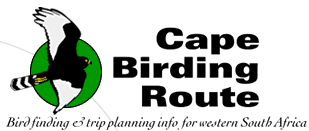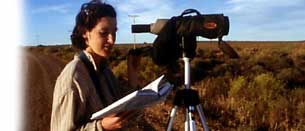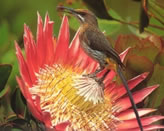|
|
Seawatching
from the Peninsula:
Those who don’t trust their sea legs may consider taking
their telescopes out on a windy day and gazing out to sea to
search for pelagic seabirds that are blown inshore. Although
the popularity of this pastime has declined recently due to
the increased availability of pelagic birding trips, there are
still some sites worth visiting on the Peninsula if you are
a hardened seawatcher or a weakened seafarer.
In
winter, seawatching is best on the western side of the Peninsula
when a strong northwesterly is blowing. Try to find a position
elevated enough to preclude your quarry dipping infuriatingly
behind the wave troughs, and if possible sheltered from light
rain squalls. The best spots are at the Cape of Good Hope
(find a sheltered vantage point on the cliffs above the parking
area; see map p.14), Cape Point (take the path from the old
lighthouse to the new one; p.22) and Kommetjie (from the shore
near the lighthouse; p.22). Even the casual seawatcher is
bound to see a sprinkling of Cape Cormorant, Cape
Gannet, White-chinned Petrel and Sooty Shearwater
just offshore. If there is a strong wind, Shy and Black-browed
Albatrosses may also be seen, with regular appearances
made by Sub-Antarctic Skua, Northern and Southern
Giant Petrels, Yellow-nosed Albatross, Wilson’s
Storm Petrel and Broad-billed Prion.
In
spring, summer and autumn, the persistent southeasterly winds
produce good seawatching, and the best vantage points are
Glencairn (made famous by seawatching expert, Dr Mike Fraser)
and Cape Point. Glencairn is a small suburb on the east coast
of the Peninsula, between Fish Hoek and Simon’s Town.
Stand next to the railway station, or at the whale-watching
site 1 km north of the railway station. The seawatching is
best in spring and late summer (October and February–March)
on the first or second day of the southeaster. Birds are blown
into False Bay and are best viewed in the late afternoon as
they move south, out of the bay. Most common are Cape Gannet,
Arctic Skua, Sooty Shearwater and White-chinned
Petrel. Less common but regular nonetheless are Pomarine
Skua and Cory’s Shearwater; scarcer
still are Soft-plumaged Petrel, Great Shearwater
and Long-tailed Skua.
In
summer, scan offshore from the Mouille Point lighthouse (just
west of the V&A Waterfront, see p.31) for distant flocks
of Sabine’s Gull (October–April), as well
as Cape Gannet, White-chinned Petrel, Arctic
Skua and Swift Tern.
|
This website is maintained by Birding Africa.
Please do not use any text, images or content from this site without
permission.
© Birding Africa 1997-2009 info@capebirdingroute.org
4 Crassula Way, Pinelands, 7405, Cape Town, South Africa
|

27/09/09: Dalton
Gibbs reports back from Gough
Island! Read the blog!
26/09/09: New Cape
Town Pelagics trip report from trips of 12 and 19 September
2009.
30/08/09: British
Birdwatching Fair at Rutland Water proved very successful,
with sunny weather and over 20,000 visitors. Callan's "Birding
Namibia and the Okavango" was the most highly-attended
lecture on the Saturday, with over 240 people. Congratulations
to the winners of the Birding Africa competition and the
African Bird Club raffle that we helped sponsor!
12/08/09: New Cape
Town Pelagics trip reports from August and July 2009.
Highlights: Little
Shearwater and more!
07/08/09: The
sub-adult Black Sarrowhawk visits our garden again! Read
on about Raptor Research in the Western Cape.
27/07/09: Cape
Town's Verreauxs' Eagle Chick has grown! And its sibling
never had a chance to hatch. See the pictures of the chick,
its nest and the breeding pair. Find out more about the Western
Cape Raptor Research Programme.
27/07/09: To follow modern nomenclature and systematics, we've
adopted the IOC
World Bird List, Version 2.1.
13/07/09: The 8th
African Bird ID Challenge has launched! Win a 50% discount
on a Cape Town Pelagics
trip, a copy of Southern
African Birdfinder, or African
Bird Club membership for 1 year.
6 July 09: Cape
White-eye research in our garden.
2 July 09: Cape
Town's Verreauxs' Eagle Chick has hatched! See the pictures
of the chick, its nest and the breeding pair. Find out more
about the Western Cape Raptor Research Programme.
2 July 09: Campbell
Fleming, a Cape Town scholar, avid birder and photographer,
joined Birding Africa last month as an intern. Click here,
to see what he got up to.
2 July 09: New pelagic
trip reports from the Cape Town Pelagics trips in June
2009. Highlights: Slenderbilled
Prion and Leach's Storm Petrel
30 july 09: Our latest Cape Fynbos and Karoo trip
reports feature Hottentot
Buttonquail, Cinnamon-breasted
Warbler and other fynbos and Karoo endemics...
26 June 09: Tungsten
mining threatens RAMSAR site, South Africa's Verlorenvlei.
Read the Media Release.
22 June 09: Claire
Spottiswoode, one of the Cape Birding Route founders,
was part of the exploratory team at Mount Mabu. The mountain
is part of the newly discovered largest
rainforest in Southern Africa.
11 June 09: A colour-ringed
Black Sparrowhawk visits the Birding Africa office garden.
Read why it's a 10 months old male!
14 June 09:
Wildlife
at the office of The Cape Birding Route, Birding Africa
and Cape Town Pelagics.
31 May 09:
Michel Watelet wins the 7th African Bird Club & Birding Africa
ID Challenge. Test your African birding skills and WIN
a Birding
Africa Cape town day trip or a copy of the Birdfinder!
30 May 09:
A tragedy unfolds at Kommetjie south of Cape town as 44 beached
False
Killer Whales were shot. Click here for more details and
pictures.
14 March 09: Raptor
Watch in Cape Town on 14 March 09
|
|


